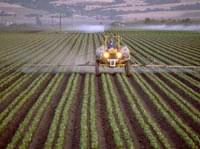Science Brief: Worse than Weeds? Herbicides in our Communities and Lake

Summertime bounty in the Champlain Valley often means the weeds are growing wild, too. Many farmers and homeowners turn to a quick fix: herbicides. Is it safe for our communities and the Lake? Or is it worse than weeds?
The most widely used herbicide in the United States is glyphosate, the active ingredient in Roundup and AquaPro, among others, with over 180 million pounds applied annually to home gardens and agricultural and commercial areas. It also is widely used to clear railroad tracks of weeds and to manage roadsides.1 Glyphosate is a non-selective herbicide and works by blocking enzymes that synthesize amino acids. In other words, it affects most actively growing plants by inhibiting growth at the sub-cellular level, because those amino acids help create proteins that would then become cell walls and other plant structures.
Monsanto first created and patented Roundup in the early 1970s and followed its immediate success with a line of patented glyphosate-resistant crop seeds, marketed as Roundup Ready®.
Globally, glyphosate has dramatically improved crop yield potential, thereby reducing hunger. The World Health Organization, the European Food Safety Agency and the US Food and Drug Administration all classify glyphosate as non-toxic for both the environment and for people.2,3
But several recent scientific journal articles investigated the link between glyphosate and increased cancer risk, citing evidence that chronic exposure to the pesticide may have adverse health effects, such as increased risk of non-Hodgkin’s Lymphoma, breast cancer and other chronic diseases.4,5,6 Glyphosate also has been shown to have negative effects on microbial life in soils, and on fish and amphibians in water environments, causing larval die-offs, deformities and long-term soil health degradation.7 The articles were published in time to be reviewed by the EPA in the summer of 2013 as it opened public discussions of a Monsanto proposal to increase the acceptable limit of glyphosate residue on ready-to-eat crops such as lettuce and fruits. The EPA approved Monsanto’s threshold increase requests and its provisional approval is not expected to change.8
During 2011, glyphosate was applied to 31% of all planted corn acres and 92% of all soybean acres in the United States.9 Glyphosate resistance was recently documented in several weed species, and some areas now require multiple pesticide applications to keep these new “SuperWeeds” at bay. In 2010, researchers estimated as many as 7-10 million US acres were affected by SuperWeeds.10 Scientists are working to determine how these weeds became resistant and are investigating alternatives to prevent excessive use of herbicides.
Companies manufacturing pesticides are mandated by law to exhaustively test the toxicology of their products before and after they are released to the public, so it is not surprising that most available information about glyphosate was funded by and is reported by Monsanto. Results published by Monsanto show the product to have very low toxicity to humans. However, fewer test results have been published by independent parties and more objective research is needed.
Until the problem is fully understood, farmers and home gardeners are urged to err on the side of safety if they choose to apply herbicides to their fruit and vegetable gardens.
For more information: Alternatives to reliance on herbicides alone are attractive. EPA describes Integrated Pest Management (IPM) as: “…an effective and environmentally sensitive approach to pest management that relies on a combination of common-sense practices”. IPM includes a careful assessment of the management problems to be solved, and a measured response using a variety of tools such as weeding, rotating cover crops, soil amendments, and minimal use of chemical management, such as an herbicide. For more information, see http://www.epa.gov/pesticides/biopesticides/ or the nationwide network of Cooperative Extension Services http://nifa.usda.gov/program/integrated-pest-management-program.
Science magazine published a special issue on Pest Management on August 13, 2013, with user-friendly infographics and free access to full-length articles and podcasts (http://www.sciencemag.org/site/special/pesticides/index.xhtml).
Citations:
1. Grube, A.; Donaldson, D.; Kiely, T.; Wu, La. 2011. Pesticides Industry Sales and Usage, 2006-2007 Market Estimates. Environmental Protection Agency, 44 p.
2. Environmental Protection Agency 1992. Final Report #820R92110: Drinking Water Criteria Document for Glyphosate, 48 p.
3. World Health Organization 1994. Environmental Health Criteria 159: Glyphosate; 155 p. ISBN 92 4 157159 4.
4. Alavanja, M.; Ross, M.; Bonner, M. 2013. Increased cancer burden among pesticide applicators and others due to pesticide exposure; CA Cancer Journal for Clinicians, 63, pp. 120-142.
5. Mink, P.; Mandel, J.; Sceurman, B.; Lundin, J. 2012. Epidemiologic studies of glyphosate and cancer: A Review; Regulatory Toxicology and Pharmacology, 63, pp. 440-452.
6. Thongprakaisang, S.; Thiantanawat, A.; Rangkadilok, N.; Suriyo, T.; Satayavivad, J. 2013. Glyphosate induces human breast cancer cells growth via estrogen receptors; Food and Chemical Toxicology, 59, pp. 129-136.
7. Wagner, N.; Reichenbecher, W.; Teichmann, H.; Tappeser, B.; Lotters, S. 2013. Questions concerning the potential impact of glyphosate-based herbicides on amphibians; Environmental Toxicology and Chemistry, 32, 8, pp. 1688-1700.
8. Federal Register of Rules and Regulations Vol. 78, No. 84 / Wednesday, May 1, 2013 (40 CFR Part 180 [EPA–HQ–OPP–2012–0132; FRL–9384–3]).
9. United States Department of Agriculture, National Agricultural Statistics Service 2011. Agricultural Chemical Use: Corn, Upland Cotton and Fall Potatoes 2010; 4 p.
10. Miller, A.; Gervais, J. A.; Luukinen, B.; Buhl, K.; Stone, D. 2010. Glyphosate Technical Fact Sheet; National Pesticide Information Center, Oregon State University Extension Services.